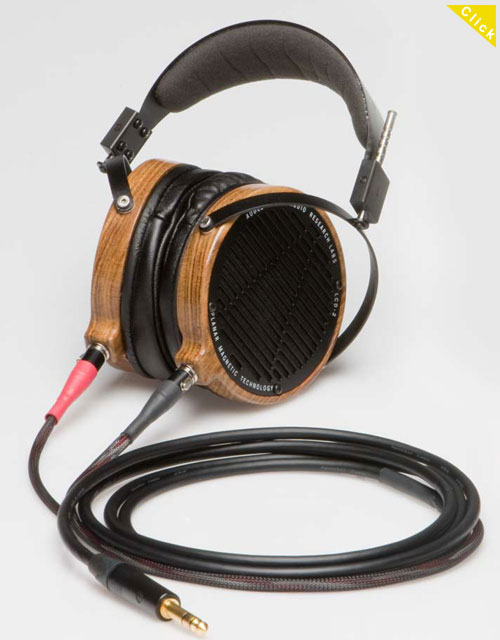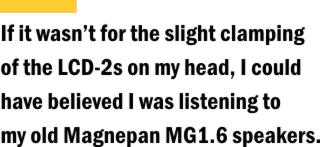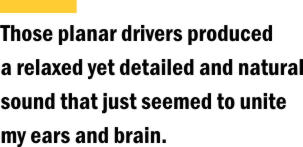Audez'e • LCD-2 Headphones
udez’e is headquartered in Las Vegas, not exactly a hotbed of consumer-electronics activity, the once-a-year Consumer Electronics Show notwithstanding. It was founded by "a group of like-minded friends with a common interest in music," to quote one of the company's founders, Alexander Rosson. The company launched by designing several prototype headphones, choosing what they felt was the best one to modify. All this happened around the time of CanJam 2009, Head-fi.org's annual listening meet, so the Audez’e crew took their 'phones to the meet in Los Angeles and solicited feedback. Apparently the feedback was uniformly positive, and Audez’e the company was born, launching with sales of 25 pairs of LCD-1 headphones.
The LCD-2s were the company's answer to the challenge of making an even better set of headphones. They are an open-back, push-pull, planar-magnetic design with a 6.17-square-inch diaphragm made out of extremely thin film and laminated with aluminum. Audez’e manufactures nearly every part used for the LCD-2s. They etch the aluminum themselves and mount it on the drivers. They use twelve neodymium magnets for each driver, which creates a powerful flux within which the diaphragm lies. It also allows Audez’e to keep tolerances for each driver within +/- .05dB. The LCD-2s come with a twin-mini-XLR plug-in cable, which connects at the base of each earpiece. This makes swapping out cables for different ones of your choice an easy option. And here lies one of the few nits I’ll pick with the LCD-2s as they come from the factory. While sonically more than acceptable, the cable that comes stock is aesthetically unwieldy. Its fabric is somewhat inflexible, and when it rubs, as it often does, it creates noise. Audez’e's own measurements of the LCD-2s indicate wide frequency response of 5Hz-20kHz, impedance of 50 ohms, and sensitivity of 91dB, with a maximum output of 133dB at 15 watts and 1% THD at maximum output. These impressive specs mean the LCD-2s should be an easy load for almost any amp -- a fact borne out by the diverse group of amps I used to drive them successfully. Due in part to the materials used, such as genuine lambskin for the circumaural earpad covers, real wood for the driver chassis, and metal for the grilles and headband, the LCD-2s are not light, weighing 19.4 ounces. They also clamp tightly to the head (though less so with new pairs, due to customer feedback). Yet, even with all that, they don’t feel particularly heavy or uncomfortable. I will even go so far as to call them quite comfortable, the equal of many 'phones that are their competition. he sound of the Audez’e LCD-2s was very different from that of the dynamic headphones I’m used to. Instead of thrusting the music outward, they floated it, creating a relaxed presentation that made me want to listen all day long.
I’ve been blessed to have as a good friend former Loggins and Messina drummer and now recording engineer Merle Bregante. Through him I’ve been sent one-off 24-bit/96kHz or 24-bit/48kHz DVD-A burns of albums he has engineered. I have his wife Sarah Pierce's Cowboy’s Daughter and one by singer/songwriter Eric Hanke, Factory Man. I listen to them frequently. With the LCD-2s, the presentation was full-bodied and rich, and the singing, whether it was male or female, was nothing short of realistic. Both recordings are packed with acoustic instruments -- captured with little or no compression -- and they sounded quite realistic as well. From the finger-on-strings sound of the acoustic guitars, to the snap of the stick on the snare-drum head, all was according to Hoyle. There was fullness to the lower frequencies that was quite astounding. Full, deep, tight bass was the norm via the LCD-2s. I put on the Stanley Clarke CD East River Drive [Epic EK 47489] and dialed up the tune "Lord of the Low Frequencies." And, Lord, the LCD-2s certainly were. There was almost perfect purr from Clarke's electric bass, along with well-defined sound that extended to the lowest reaches of his electric guitar. The bass, while deep, clean, and precise, didn’t have quite the forceful drive that some dynamic drivers can offer, but, on the other hand, there was nothing boomy or bloated -- just weigh and depth. The Audez’e LCD-2s have a typical planar midrange -- quick-paced, smooth, sweet, and utterly natural. Here, too, there wasn't anything forced about the presentation -- just music that seemed to flow from the headphones to my ears. Russell Malone’s hollow-body electric guitar from his CD Playground [MaxJazz MXJ 601] was a perfect example. I could hear both his hands on the strings and the way the strings excited the body of the guitar -- along with the full sound coming from his amp. This made for suspension of disbelief -- a very rare thing with any headphones. Another aspect that emphasized the midrange naturalness was the way the LCD-2s captured the totality of each note, which was individual, a separate entity that trailed off into silence. There was neither foreshortening nor prolonging, only what I would expect to hear from a great pair of speakers -- or live music. The opening guitar plucks from Eleanor McEvoy’s cover of Marvin Gaye’s "Mercy, Mercy Me" from the album Out There [Moscodisc MOSACD303] were amazingly clear, clean and precise. It was a real guitar playing in real space through these headphones. I could easily understand why the LCD-2s were being used in recording studios despite being open-backed. Engineers want to hear exactly what was laid down, and that's what the Audez'e 'phones provide. The top end of the LCD-2s was also well handled. High frequencies seemed to float in space in a manner that sounded more realistic than with most dynamic headphones. Cymbals had the requisite shimmer, with the decay of each strike wafting off, just as I hear when listening to a drum kit live. However, the highs, while in keeping with the overall frequency balance, didn’t sparkle quite as much as with some other 'phones. Does this mean that the LCD-2s sound too smooth and perhaps even soft? Not to my ears. I'll take their ease over aggression any old day. Another strong point is the way the LCD-2s handled dynamic swings. After Eleanor McEvoy finishes the mid-to-slow tempo of "Mercy Mercy Me," she launches into a far more up-tempo tune, "Quote, I Love You, Unquote." The LCD-2s handled that jump in tempo and its corresponding dynamic swing without a hiccup. Along with dynamics, the way the Audez’e 'phones presented detail was first rate. Oh yes, all the detail was there, but what was truly impressive was that it was not presented as simply detail for its own sake. Instead, it was part of the music's fabric. It was there if I wanted to focus on it. I admired this about the 'phones. They addressed both the music lover and picky audiophile in me. uring the review period, I was blessed with having the $10,000 Apex Pinnacle headphone amp also in for review. Along with the amp, Pinnacle creator Todd Green -- aka Todd Vinyl Junkie -- sent me some of his personal stash of headphones to use with the amp. Thus I had a cornucopia of high-end headphones, including Grado PS1000s ($995), Sennheiser HD 800s ($1399), and Beyerdynamic Tesla T1s ($1295) to go along with my AKG K-701s ($499) -- and the Audez'e LCD-2s, of course. While I definitely heard a few broad similarities among all of the headphones -- chief among them the ability to resolve copious amounts of musical detail -- each pair had its own unique take on the music. I was surprised to find that the Grados offered a sound that I could very easily live with -- I've never been a Grado fan -- sounding clean, relatively neutral and evenhanded. The Beyerdynamic 'phones were a tad darker and a bit more closed in than the Grados. Even for an open-backed headphone, they didn’t leak a lot of sound into the room. The Sennheisers were my least favorite. They were just too dark, rich, and heavy in the bass for my tastes. As for my reference AKG K701s, the LCD-2s take everything I like about them and add deeper, tighter bass, cleaner highs, and a more sophisticated and tonally accurate midrange. In fact, none of the top-fight headphones I had on hand came close to equaling the manner in which the Audez’e LCD-2s reproduced music. They took the tonal balance of the Grados and went a step further. They sounded far more open and airy than the Beyerdynamic 'phones, and they seemed to offer just as much bass as the Sennheisers, but with a more even low-frequency balance. And they displayed the overall neutrality of the AKGs, adding a sense of ease that only they achieved, even among this rarefied group of peers. In regard to amps, all of the ones here had enough oomph to drive the LCD-2s, but, yes, the Apex Pinnacle was the best of them all by a Grand Canyon-sized margin. If you’re just getting started in the headphone world and the LCD-2s are in your sights and budget, my suggestion is buy a pair of them and the best amp your budget will allow. As time and funds permit, upgrade your amp. The LCD-2s will always wring the most out of it.
The LCD-2s are easily the finest headphones I’ve yet
heard, and, even with taste being what it is, they are among the finest headphones
available today. If you endeavor to hear a pair, be sure you're ready to buy them.
|


 The very first thing I noted was how
smooth, sweet, silky, and relaxed the sound was. The music was just there, not forced in
any way. If it wasn’t for the slight clamping of the LCD-2s on my head, I could have
believed I was listening to my old Magnepan MG1.6 speakers. There was a coherent,
whole-piece, complete sonic presentation with well-defined instrumental separation and
absolutely no smearing of notes.
The very first thing I noted was how
smooth, sweet, silky, and relaxed the sound was. The music was just there, not forced in
any way. If it wasn’t for the slight clamping of the LCD-2s on my head, I could have
believed I was listening to my old Magnepan MG1.6 speakers. There was a coherent,
whole-piece, complete sonic presentation with well-defined instrumental separation and
absolutely no smearing of notes. learly, the Audez'e LCD-2s
pushed all the right sonic buttons for me. Those planar drivers produced a relaxed yet
detailed and natural sound that just seemed to unite my ears and brain. The LCD-2s are
well made and beautiful -- I love that real wood -- and they're comfortable to wear,
making long listening sessions possible and all the more rewarding. If you're lucky enough
to own a pair, you won’t feel the need to upgrade anytime soon -- if ever.
learly, the Audez'e LCD-2s
pushed all the right sonic buttons for me. Those planar drivers produced a relaxed yet
detailed and natural sound that just seemed to unite my ears and brain. The LCD-2s are
well made and beautiful -- I love that real wood -- and they're comfortable to wear,
making long listening sessions possible and all the more rewarding. If you're lucky enough
to own a pair, you won’t feel the need to upgrade anytime soon -- if ever.